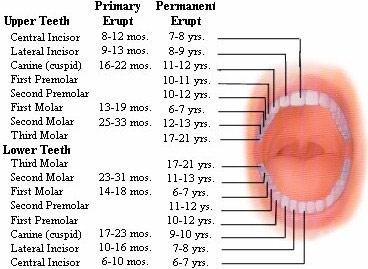What is a pediatric dentist?
A pediatric dentist has an extra two years of specialized training after dental school and is dedicated to the oral health of children from infancy through the teenage years. The very young, pre-teens, and teenagers all need different approaches in dealing with behavior, guiding their growth and development, and helping them avoid future dental problems. With the additional education, pediatric dentists have the training which allows them to offer the most up-to-date and thorough treatment for a wide variety of pediatric dental problems.
How do I prepare my child for his or her first dental visit?
It is best that you refrain from using words around your child that might cause unnecessary fear, such as “needle”, “drill”, “shot”, “pull”, or “hurt”. Our office makes use of words that convey the same message, but are pleasant and non-frightening to the child.
Why are baby teeth so important?
It is very important to maintain the health of primary teeth (baby teeth). Neglected cavities can cause pain and infection, and it can also lead to problems which affect the developing permanent teeth. Primary teeth are important for (1) proper chewing and eating, (2) providing space for permanent teeth and guiding them into position, and (3) permitting normal development of the jaw bones and muscles.
Why does my child need dental x-rays?
Radiographs (x-rays) are often a necessary part of your child’s dental diagnostic process. Without them, certain cavities will be missed. They also help survey developing teeth, evaluate results of an injury, or plan for orthodontic treatment. If dental problems are found and treated early, dental care is more comfortable for your child, and more affordable for you.
Dental Emergencies
Toothache
Clean the area around the sore tooth thoroughly. Rinse the mouth with warm salt water or use dental floss to dislodge impacted food or debris. DO NOT place aspirin on the gum or on the aching tooth. If the face is swollen or the pain persists, contact our office as soon as possible.
Knocked out Permanent Tooth
Find the tooth. Handle the tooth by the crown, not the root portion. You may rinse the tooth, but DO NOT wipe or handle the tooth unnecessarily. Inspect the tooth for fractures, if there are no fractures, try to reinsert it into the socket. Have the patient hold the tooth in place by biting on a gauze. If you cannot reinsert the tooth, transport the tooth in a cup containing cold milk. If there is no milk, place the tooth in a cup containing the patient’s own saliva. DO NOT place the tooth in water. Call our office immediately. Time is a critical factor in saving the tooth.
Knocked out Baby Tooth
Find the tooth. Do not attempt to reinsert the tooth. Contact our office to examine the injured area.
Displaced or “Pushed In” Teeth
Avoid biting with the injured teeth. Keep the injured area as clean as possible. Contact our office to examine the injured area.
Fractured Tooth
Rinse debris from injured area with warm water. Place cold compresses over the face in the area of injury. Locate and save any broken tooth fragments in milk. If your child experiences severe pain, contact our office as soon as possible.

Further resources:
The American Academy of Pediatric Dentisty

